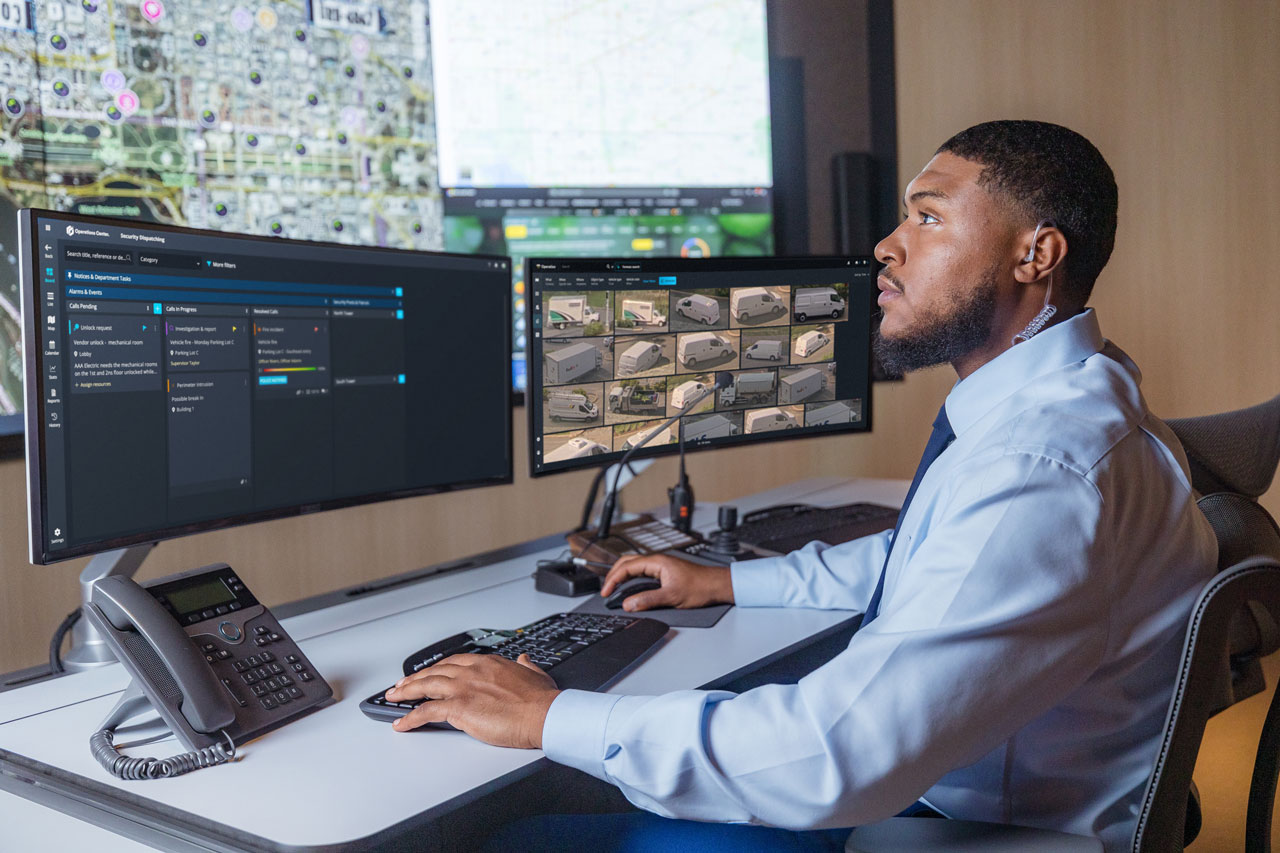How automation enhances physical security operations
Learn how AI and intelligent automation optimize security operations with digital workflows, real-time SOPs, and IA-driven intelligent search tools.

Automation in physical security starts with digitization. By replacing manual processes with digital systems, you can streamline operations, improve response times, and reduce human error.
In this post, you’ll learn about the role of automation in physical security, what it means, and how it enhances efficiency, safety, and resource management.
EBOOK
What is digitization in physical security?
In physical security, digitization means transitioning from manual, paper-based processes to digital systems. This includes converting security logs, incident reports, and other records into digital formats for easier access, analysis, and storage. More than just going paperless, digitization integrates security technologies—like video surveillance, access control, and alarms—into a unified platform for better visibility and faster response times.
Why digitization matters:
- From analog to digital – Handwritten reports and physical logs are replaced with electronic records that are easier to store, search, and share.
- Centralized security management – Different security systems connect to a single platform, simplifying data analysis and reporting.
- Stronger insights – Digital data can be analyzed to identify trends, detect risks, and improve decision-making.
Real-world examples of digitization:
- IP video surveillance – Upgrading from analog cameras to network-connected systems that stream high-definition digital video.
- Cloud-based access control – Managing credentials and permissions remotely without relying on physical keycards.
- Automated incident reporting – Using security sensors and AI-driven analytics to generate reports in real time.
Digitizing security operations enhances your organization's efficiency, improves situational awareness, and strengthens your security posture.
BLOG
What is automation in physical security?
Automation in physical security refers to using technology to streamline security tasks, reducing the need for manual intervention. By automating processes like video monitoring, access control, and incident response, organizations can improve efficiency, reduce human error, and respond to threats faster.
Why automation matters:
- Increased efficiency – Routine security tasks, such as badge verifications or alarm monitoring, are handled automatically, freeing up staff for higher-priority work.
- Faster response times – Automated alerts and workflows ensure security teams react to incidents in real time.
- Reduced human error – Automated systems follow consistent rules, helping eliminate missed alerts or incorrect responses.
Real-world examples of automation in security:
- AI-powered video analytics – Cameras can detect unusual activity, such as unauthorized access or loitering, and trigger alerts without constant human monitoring.
- Automated access control – Systems can grant or revoke entry based on preset rules, such as time of day or employee status.
- Incident response workflows – When a security event occurs, automated systems can send alerts, lock doors, and notify first responders instantly.
By integrating automation, organizations can enhance security, improve situational awareness, and optimize resources—ensuring a more proactive and responsive approach to threats.
BLOG
How SOPs improve operational efficiency
Standard operating procedures (SOPs) provide security teams with clear, step-by-step guidance for handling incidents efficiently. Dynamic SOPs adapt to different situations, whether it’s de-escalating a tense situation in a hospital or managing a fire evacuation. By standardizing responses, organizations can improve decision-making and ensure a consistent approach to security events.
Why SOPs matter:
- Structured response – Operators follow a clear workflow, ensuring incidents are handled correctly and consistently.
- Faster resolution – Automated escalation and response time limits help security teams react quickly to critical situations.
- Greater accountability – Incident tracking ensures that all actions are logged, improving transparency and compliance.
Real-world applications of SOPs:
- Retail security – Floor managers and security teams follow SOPs for customer incidents, inventory control, and theft prevention.
- Automated incident workflows – Security platforms can assign priority levels, enforce response deadlines, and escalate issues if action isn’t taken in time.
- Loss prevention analysis – Systems like Gatekeeper, which locks shopping cart wheels when unpaid items approach exits, generate incident reports that loss prevention teams can analyze for trends across multiple stores.
By integrating SOPs with automation, your security teams can respond more effectively, improve coordination, and maintain a high level of operational efficiency.
BLOG

AI, IA, and intelligent search are accelerating investigations
AI-powered intelligent search tools help security teams quickly analyze large amounts of data, cutting investigation times from hours to seconds. With AI, teams can easily scan video footage, access logs, and sensor data to find key details.
Intelligent automation (IA) takes this further by combining AI with automation to streamline tasks and improve decision-making. By handling repetitive work and making data analysis easier, IA helps teams work faster and more efficiently. Instead of replacing people, these tools support them, allowing security teams to focus on critical insights while AI does the heavy lifting.
How AI enhances investigations:
- Faster identification – AI can locate specific individuals or objects using facial recognition, object classification, or keyword searches.
- Proactive threat detection – Identifying patterns in security incidents helps organizations address vulnerabilities before they escalate.
- Automated evidence collection – AI streamlines data gathering and reporting, minimizing human error and ensuring accuracy.
- Enhanced situational awareness – Correlating data from multiple sources provides a more complete view of security events.
Real-world applications of automation in intelligent search:
- Retail security – Intelligent automation can scan hours of footage to detect shoplifting incidents based on specific behaviors.
- Transportation hubs – IA analyzes passenger movement patterns to detect suspicious activity and improve crowd management.
By integrating IA into intelligent search, security teams can conduct faster, more efficient investigations—improving response times, enhancing decision-making, and strengthening overall security.

A collaborative platform simplifies operations and closes training gaps
High turnover and training challenges are common in physical security. Providing operators with intuitive technology not only boosts confidence but also improves job satisfaction and overall efficiency.

A collaborative decision management system offers real-time, on-screen guidance, ensuring operators always have access to standard operating procedures (SOPs) when and where they need them. These tools also help identify areas where additional training may be required.
How a collaborative platform enhances security operations:
- Guided response – Operators receive step-by-step SOPs, interactive maps, and live video feeds to navigate incidents effectively.
- Seamless access to information – Key data appears automatically within maps or widgets, eliminating the need for manual searches.
- Mobile-friendly workflows – Security teams can follow SOPs directly from their mobile devices while on patrol.
- Customizable automation – Priorities and workflows can be tailored to streamline incident response.
- Post-incident insights – Every action is logged for review, enabling teams to analyze trends, improve training, and generate detailed reports for stakeholders.
By integrating a collaborative platform, your organization can improve response times, strengthen training programs, and create a more resilient security operation.
CHECKLIST
Digitization helps make sense of your data
Automating security procedures does more than ensure compliance—it transforms raw data into valuable insights that improve incident response and operational efficiency.
TIPS
By analyzing security data, your organization can uncover patterns that highlight potential vulnerabilities. For example:
- Equipment reliability – If cameras in a specific building frequently go offline, it may indicate the need for better infrastructure.
- Incident prevention – A trend of slip-and-fall incidents in the same area can prompt proactive safety measures.
Beyond identifying issues, these insights help refine security strategies. By considering environmental factors and historical data, you can optimize your systems to ensure faster, more effective responses—improving safety, reducing risks, and enhancing overall security operations.
